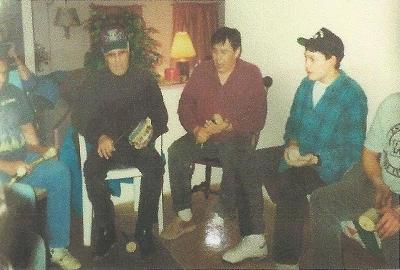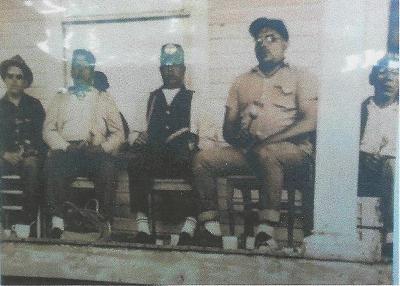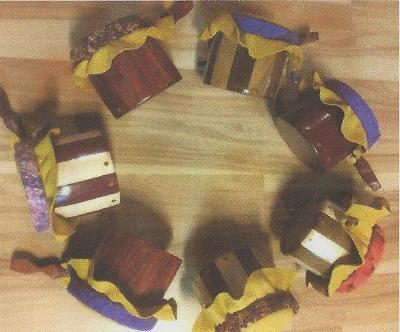 |
Canku Ota
|
 |
|
(Many Paths)
|
||
|
An Online Newsletter
Celebrating Native America
|
||
|
June 2017 - Volume 15
Number 6
|
||
|
|
||
|
So What Is Singing?
|
||
|
by Ha'johja'e:s - Gae:wanöhge'
(Seneca Language Newsletter)
|
||
So, what is singing? What's the purpose of singing? I've heard the term or phrase, "All they do is sing." When it comes to singing, it plays an important part, a piece of our Culture, our traditional ways of life. The creator has given each individual a gift, whether you're a singer, speaker, dancer, craftsman, athlete, it's up to you to find it, not everyone is a singer. The purpose of the Singing Society was to keep the singing going, keep it strong. If someone needed help with something for example: fire wood, the singers would go cut and stack wood. They would go and help out with whatever was needed. It was a considered a "spirit lifter" or "good medicine" as they would sing and pass the drum for whoever invited them into their houses. There are two types of songs, there's the social sets of songs which are meant for the public, like socials & dance programs. Then there are the ceremonial sets of songs. Those are still used but are sacred, done privately. Now, let's look at the aspect of singing, the times have changed from long time ago to the present. I always hear stories from the older, veteran singers about how it used to be. Long time ago, the singers sang every night, singing practice, singing at other people's homes.
They travelled out to sing. The singers were able to create new songs. Also, they each had their own song, or set of songs that they sang. The singing was a big part. If you listen closely to some of the songs, there's language in the songs and the songs are meant to help the people. Some have meaning and some are just songs. The singing was also a way or form of enjoyment & entertainment. It lifted the spirits of the people as it still does today. The singers travelled out to various places as well as having other singers coming in. I've always been told, "if you take a drum stick, and you have a room full of people or a house full, standing room only, that little drum stick can make everyone dance!" Nowadays, the singing has changed a lot. Today we have the modern day technology. Very rare, very, very, very rare is it done anymore and that is the singers singing in other people's houses. The last time this was done was when I was asked to gather the veteran singers and to go sing for one of our elders in his home. I gathered five veteran singers as we passed the drum and sang a couple songs. That was the last time this happened. The younger ones nowadays don't know what it was like, all we have left is the stories from the ones left. Every now and then I'll hear, "where's the singing ?", you have the language but no songs, then what good would a social and ceremony be if there were no songs ? We need both. The language and culture go hand in hand.
As I was always told, to be able to sit down and sing, you have to study the beat, the rhythm, the tune, the timing, in order to make it sound good. I always hear that when you sing, your feet are tapping the floor the same time you're beating the drum and singing. It takes a lot of practice. You can't learn it all over night. I grew up with the singing. I remember going up the cookhouse every Wednesday night for singing practice. I remember traveling out to Allegany with our older singers to the Faith Keeper School, to their community building, to Grandma Dowdy's place and to the longhouse as Allegany & Newtown Singers would gather, sing and pass the drum. It's mostly up to the men to do the singing. All of the songs have been passed down from generation to generation. Some of todays water drums are made from pvc pipes but there are still very skilled Iroquois craftsmen that make the traditional wooden water drums. For example, the picture displayed on the right, is of some drums made by Lynley Greene from the 6 Nations territory. |
||||||
|
|
||
|
|
||
| Canku Ota is a free Newsletter celebrating Native America, its traditions and accomplishments . We do not provide subscriber or visitor names to anyone. Some articles presented in Canku Ota may contain copyright material. We have received appropriate permissions for republishing any articles. Material appearing here is distributed without profit or monetary gain to those who have expressed an interest. This is in accordance with Title 17 U.S.C. Section 107. | ||
|
Canku Ota is a copyright ©
2000 - 2017 of Vicki Williams Barry and Paul Barry.
|
||
 |
 |
|
|
The "Canku
Ota - A Newsletter Celebrating Native America" web site and
its design is the
|
||
|
Copyright ©
1999 - 2017 of Paul C. Barry.
|
||
|
All Rights Reserved.
|
||


